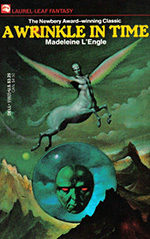
![]() theman
theman
10/5/2013
![]()
As far as I can remember, A Wrinkle in Time was my first science fiction read, and I don't think I am the only one that can make that claim. I filled my first bookshelf with tales from Narnia, Middle-Earth, and Xanth, but the Time Quartet was my first foray into Sci-Fi, outside Star Wars and Saturday morning cartoons.
And there A Wrinkle in Time sat on my bookself for three decades, although I can't remember actually reading it since about the fourth or fifth grade. In a desire for a comforting and nostaglic read, I passed by the usual suspects and settled upon Madeleine L'Engle.
I found this book's poor representation in the awards and list categories surprising. A Wrinkle in Time won the Newbery Medal, the Sequoyah Book Award, and the Lewis Carroll Shelf Award, yet its only WWE honor is "Genre Lit-flicks." In fact, no one had left any public reviews, despite being 10 months into the 2013 Women of Genre Fiction Challenge. The time was right for an old school, WoGF-eligible re-read and review.
I hate all manner of spoliers to the entent that I won't read the back cover of a book. So, I'll just say that this is a lovely novel full of quirkly characters and creative magical characters. Mrs. Whatsit, Mrs. Who, and Mrs. Which represented the wackiest whitches of the trope. I mostly enjoyed my re-read. Mostly.
There was one thing that I found annoying and left me feeling like I would never give this to my young child to read. I appreciate, as an atheist, how the majority of genre fiction is free from religion. Now, I don't mind reading books with religious characters, but I feel disconnected from the story as soon as dogma becomes part of assumptions a writer makes about its audience. There are just enough references in A Wrinkle in Time, but they are important to the plot all follow this example. For the purpose of contrast, I'll mention that I am re-reading Speaker for the Dead, which is filled with religious characters but avoids telling me what I should believe. Card uses religion to provide the setting, the culture, the internal conflicts and the character development in a way that is neither presumptive or preachy. I can escape into the story without being told by the writer that my core values are wrong.
So, I'm going to give my old Time Quartet set to someone else. I loved the book when I was younger, but reading it as an adult, I found it claiming a cultural relevency that I did not share.
Reading A Wrinkle in Time, though, brought to me attention the differences between a child reader and an adult reader. Children's mind are more adept to suspending the window of disbelief, and are far less critical of the execution of the material. As an adult reader, plot holes, writers' agendas, sloppy writing, and even the sheer amount of genre lit I've read, all serve to limit my enjoyment to only the absolute best storytelling. Perhaps, then, I am too hasty in my disdain for this classic of children's literature, not being its target audience anymore. I think I might hold onto the books a little longer, just in case my daughter wants to give them a try.